Module 3 Face Processing and Face Recognition Problems
1/71
There's no tags or description
Looks like no tags are added yet.
Name | Mastery | Learn | Test | Matching | Spaced |
|---|
No study sessions yet.
72 Terms
Prosopagnosia - define
inability to recognise familiar faces
can know they are looking at a face, but can't recognise who it is. and inability to learn new faces
prosopagnosia- Bodamer (1947)
coined the term- & potentially the 1st report of distinct face recognition impairment
prosopagnosia- Charcot (1883) and Wilbrand (1882)
reported pts with face recognition problems , but pts also had widespread perceptual problems and memory difficulties
what do people with prosopagnosia use to help them recognise people
other cues like gait, clothing, voice and context
prosopagnosia- brain damage
no clear location of brain damage that leads to it. occurs after different types of damage (bilateral hemis lesions and unilateral hemis lesions)
what might prosopagnosia be related to
might be related to impairments in holistic face processing
its hard to study- it oft co-occurs with other deficits
what other deficitis might prosopagnosia co-occur with
visual object agnosia, or cerebral achromatopsia
cognitive evidence for a specialist face processing module (system): Visual illusions with faces
face inversion effect
thompson or thatcher illusion
composite face effect
face inversion effect (Yin, 1969)
recognition more difficult for inverted comp to upright face.
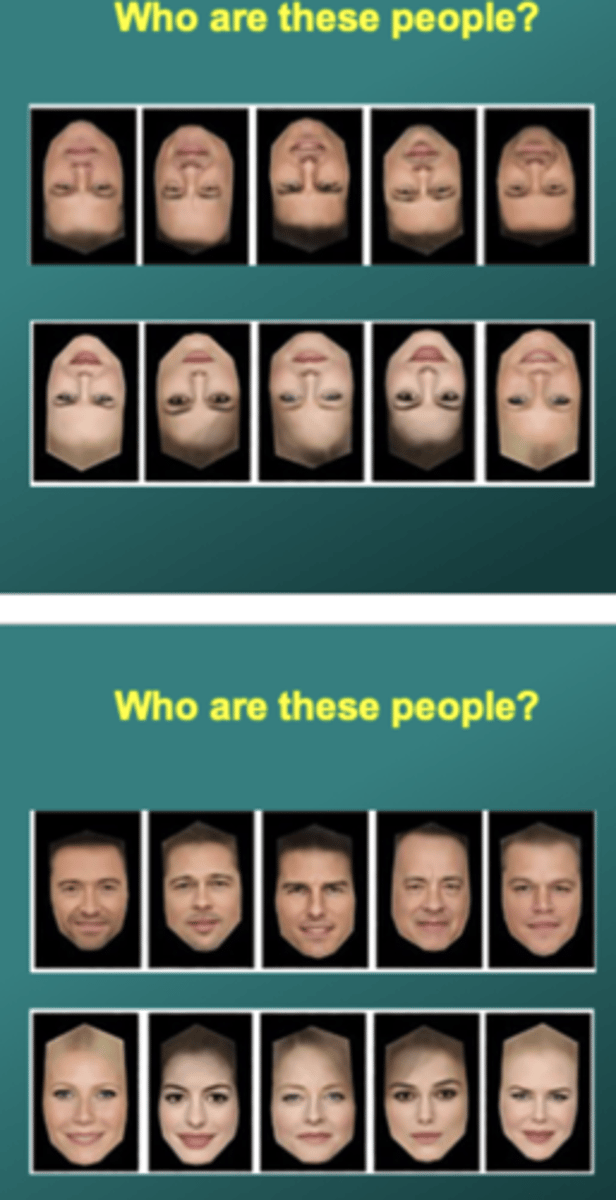
evidence for face inversion
upright faces = holistic analysis
inverted faces = analysis by parts (cannot use face systems)
Thatcher Illusion (Thompson 1980)
An upside down face of Margaret Thatcher with inverted eyes and mouth appears normal, but when this face is then turned the right way up it appears grotesque.

Composite Face Effect (Young, Hellawell & Hay, 1987)
subjects found it more difficult to name the target half of a familiar face when it was paired with a distractor half taken from a different face
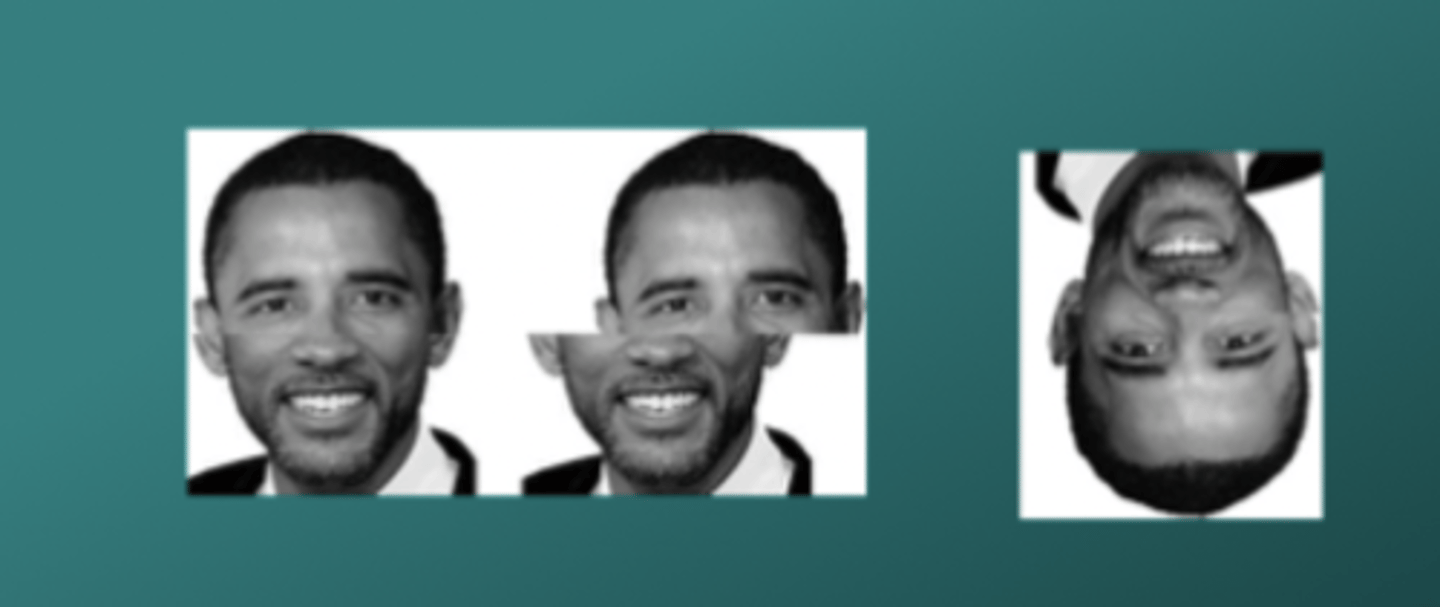
pt cognitive evidence for specialist face processing system (Farah 1990)
acquired alexia, reading problems, visual confusions between words, left hemisphere lesion, temporal lobe, specific visual agnosia, deficit, impairment in object recog
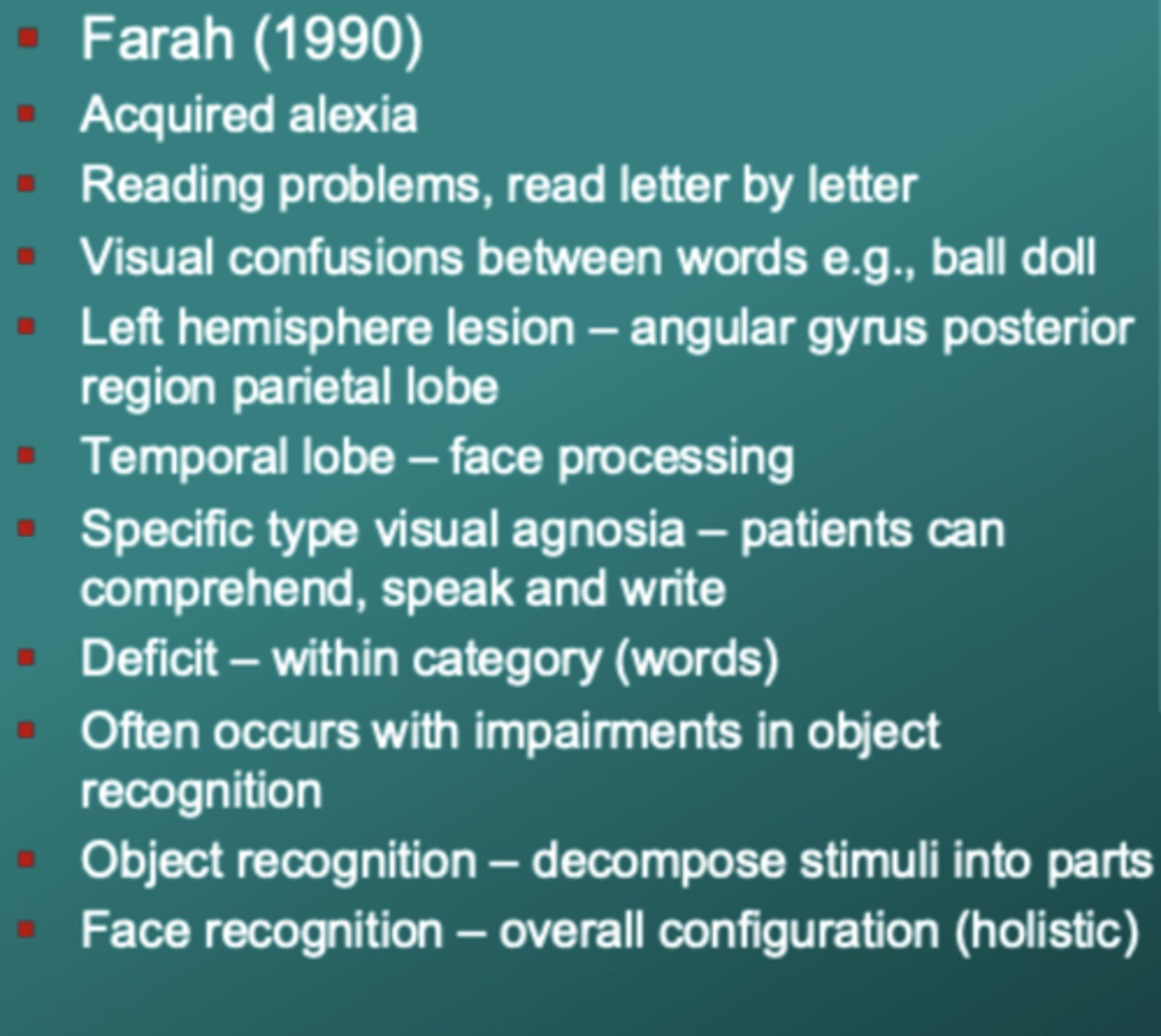
difference in processing object and face recognition
object- decompose stim into parts
face- overall configuration (holistic)
evidence to dissociate prosopagnosia from other forms of agnosia (eg. object)- sheep farmer (sheep farmer suffered multiple strokes)
pick famous faces from choices- couldn't do faces but could tell difference between his sheep
evidence to dissociate prosopagnosia from other forms of agnosia (eg. object)- Patient LH (prosopagnosia after diffuse brain damage from an accident)
2 recognition tests (face stim & eye glasses)
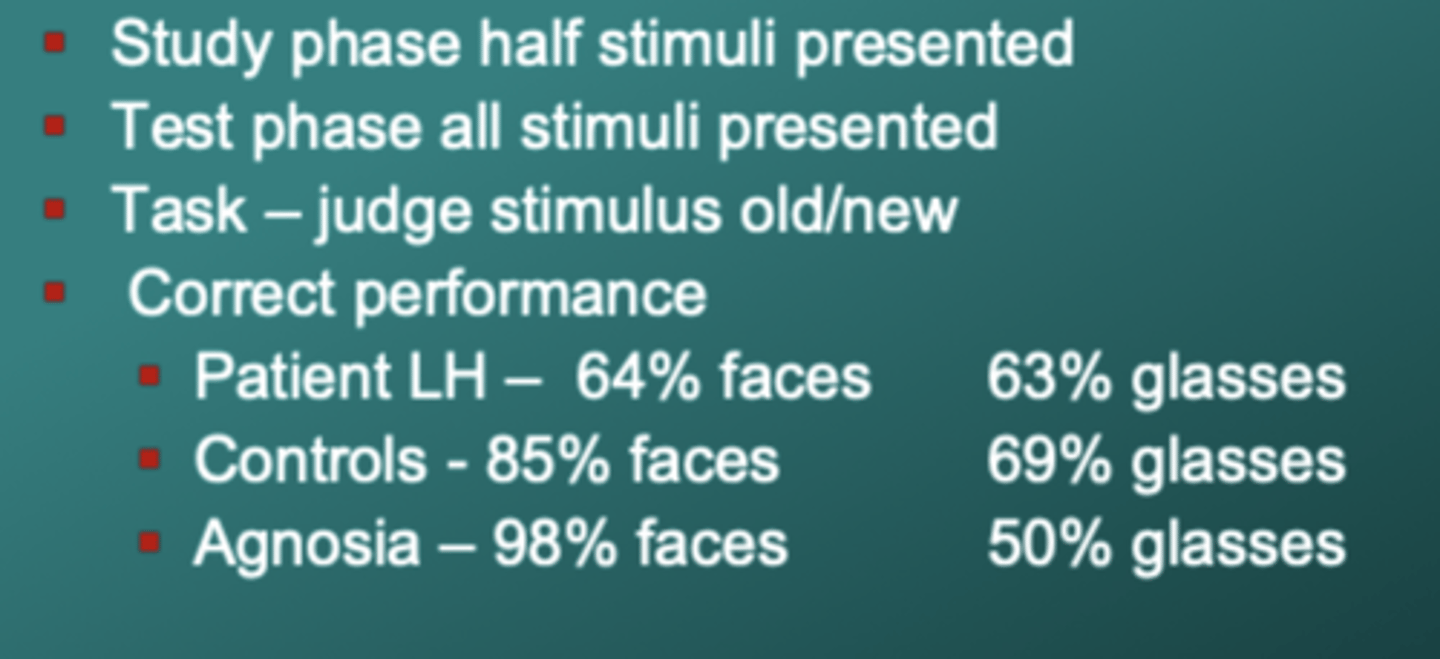
healthy ptp cog evidence for specialist face processing system (Takana & Farah 1993)
comp recognising a part of a face comp to recognising a part of an object - evidence for specialist face proc and holistic proc over parts

neural evidence for specialist face processing system
often co-occurrance of object and face recognition impairments. associated with multiple lesions. bilateral lesions- multi strokes, head trauma, encephalitis, poisoning
neural evidence for specialist face processing system -- single cell recordings in primates
superior temporal sulcus cells in monkeys - sulci and gyri of temporal lobe
found cells that selectively respond but cannot conclude it is purely for face processing
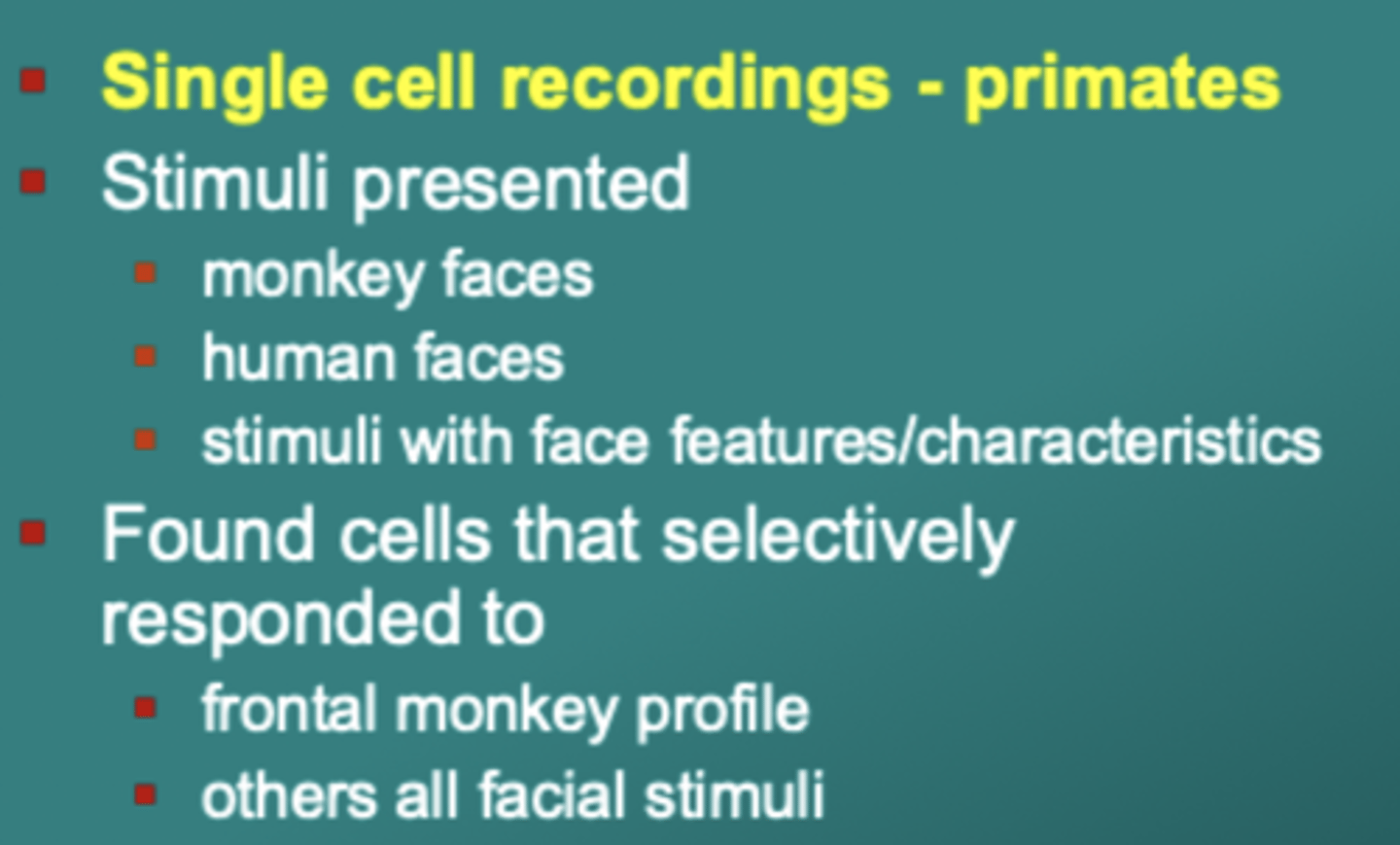
neural evidence for specialist face proc system in humans
fusiform face area

evidence for a genetic basis for prosopagnosia in normal infants
recognise difference between face-like patterns & patterns with same features (but is random after birth)
newborns distinguish between mother and other women at 2 days
babies @2mths recognise familiar faces
evidence for a genetic basis for prosopagnosia: developmental prosopagnosia
includes indivs with congenital prosopagnosia and indivs who have sustained brain damage either before birth or in early childhood
evidence for a genetic basis for prosopagnosia: congential (developmental) prosopagnosia
impairment in face processing that is present from birth, in absence of brain damage.
normal intellect and sensory
what might developmental (congenital) prosopagnosia be caused by
might be caused by generalised deficit in configural processing
evidence of it running in families
the rapid development of facial recognition in babies suggests
suggests that this skill might be modular
Bruce and Young model of face recognition 1986
hierarchical and parallel model of face recognition
uses stages of proc
allows understanding of types of diff info used when proc/recognising faces
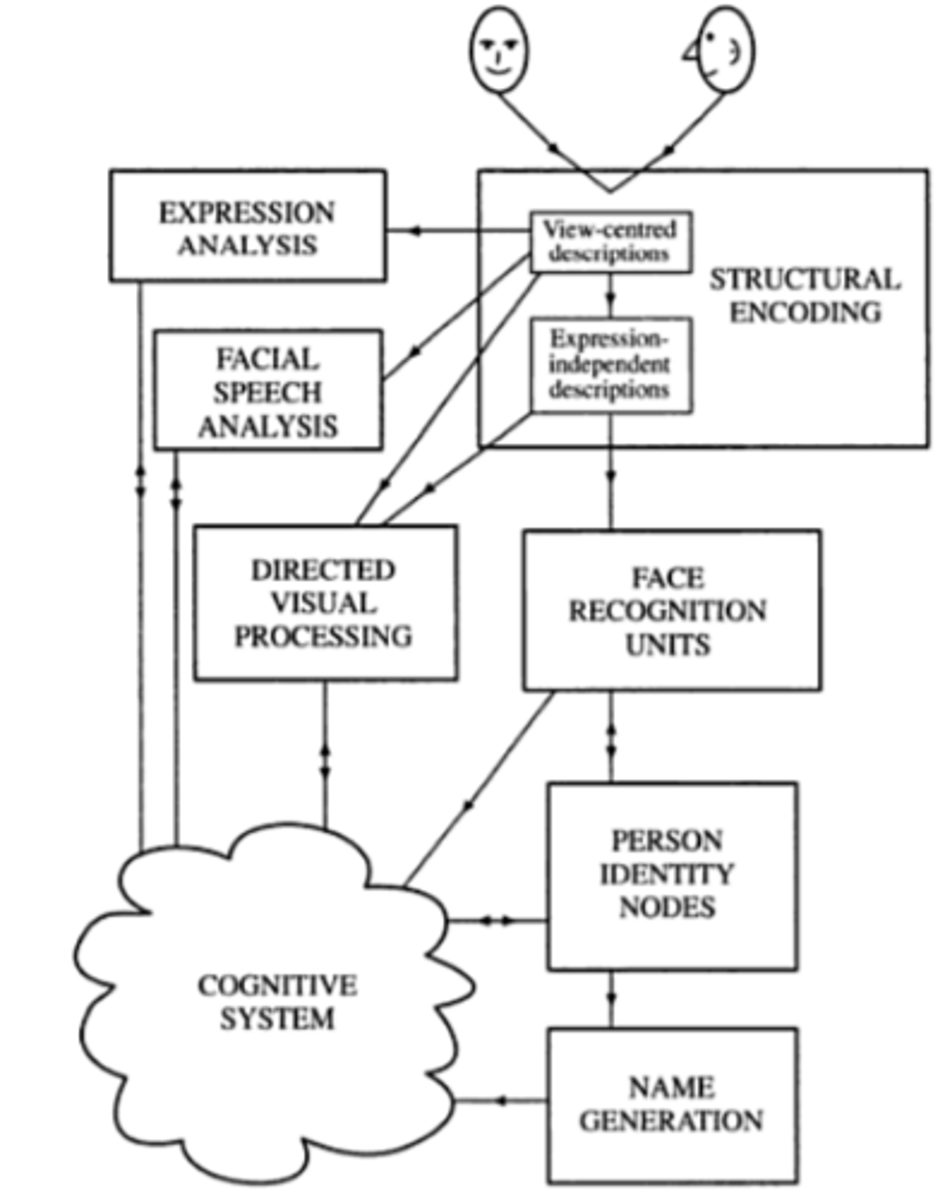
Structural Encoding stage- Bruce and Young model of face recognition
form face percept via parallel extraction of diff types of feature based info from faces
viewer centred description & expression independent descriptions
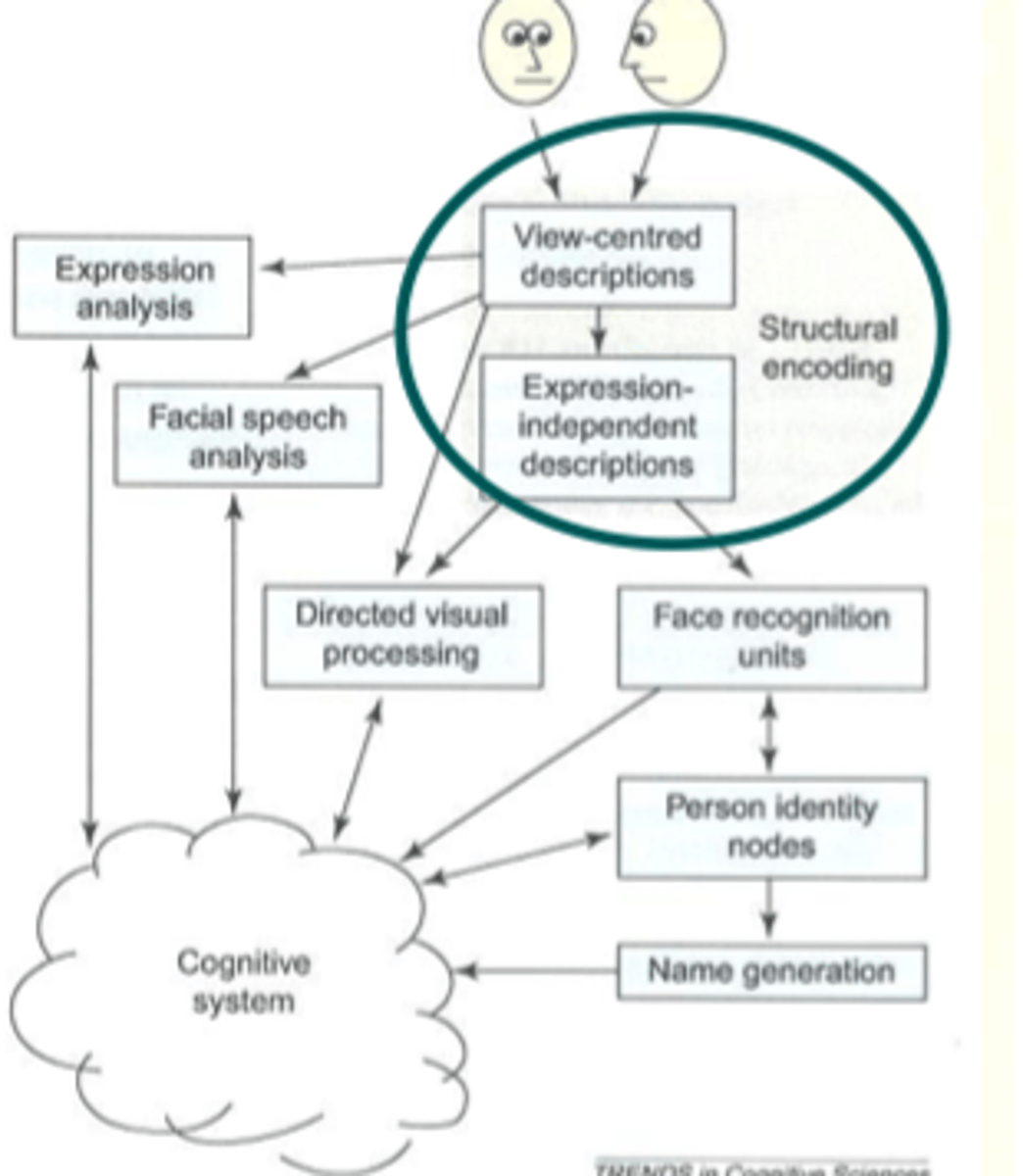
Structural Encoding stage- viewer centred description
Bruce and Young model of face recognition
viewpoint specific face representation of the face
Structural Encoding stage- viewer centred description: what does this entail
Bruce and Young model of face recognition
provides info relevant to recognition of facial expression, understanding speech, processing similarities/diffs between unfamiliar people by strategic attending to visual appearance of face
Structural Encoding stage- expression independent descriptions
Bruce and Young model of face recognition
encode diff viewpoints of face, inc configural layout of face and specific features
expression analysis
Bruce and Young model of face recognition
determine facial expression indep of face

facial speech analysis
Bruce and Young model of face recognition
info from lip and tongue movements of speaker
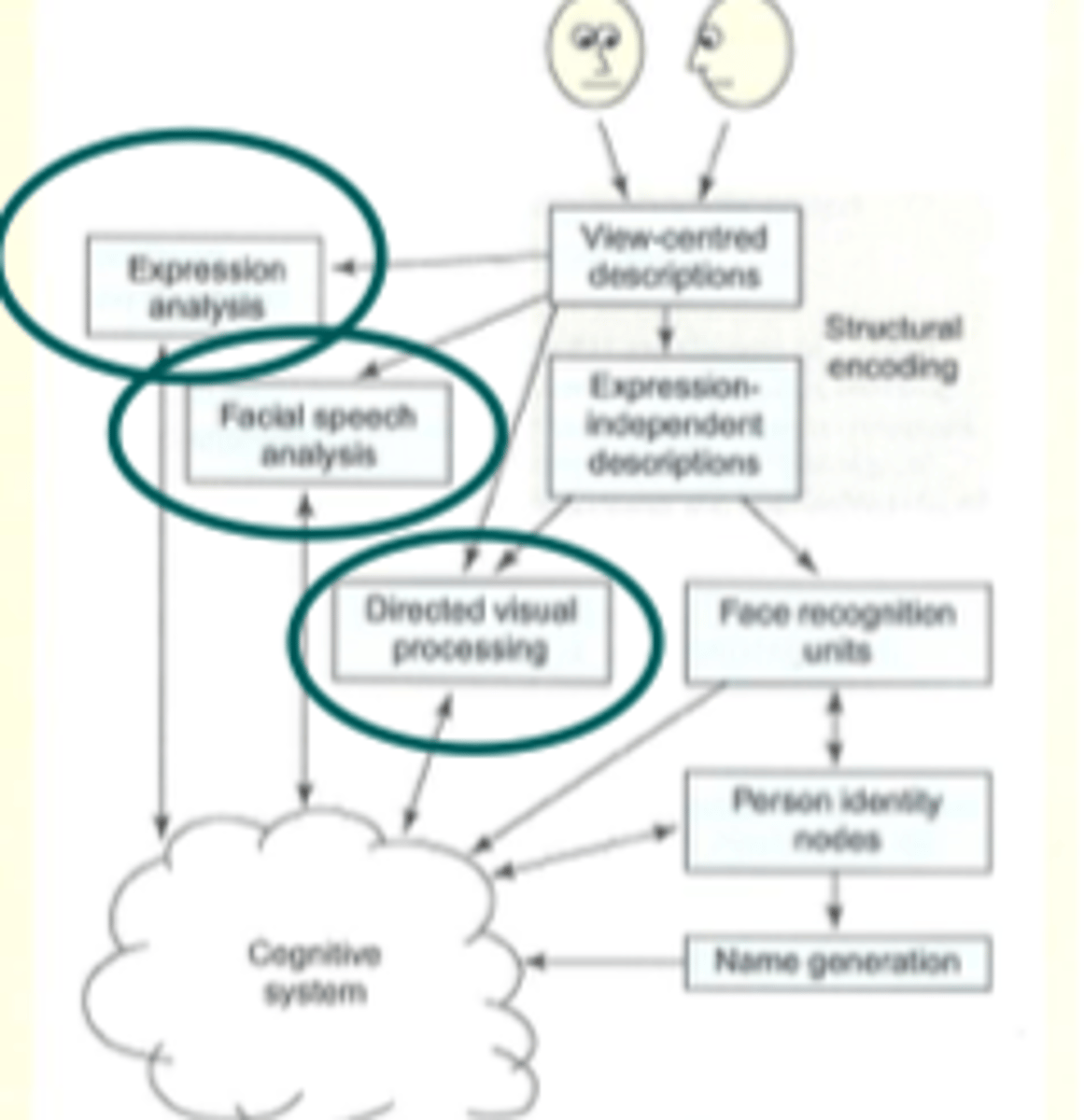
directed visual processing
Bruce and Young model of face recognition
attention to face characteristics, learning new faces
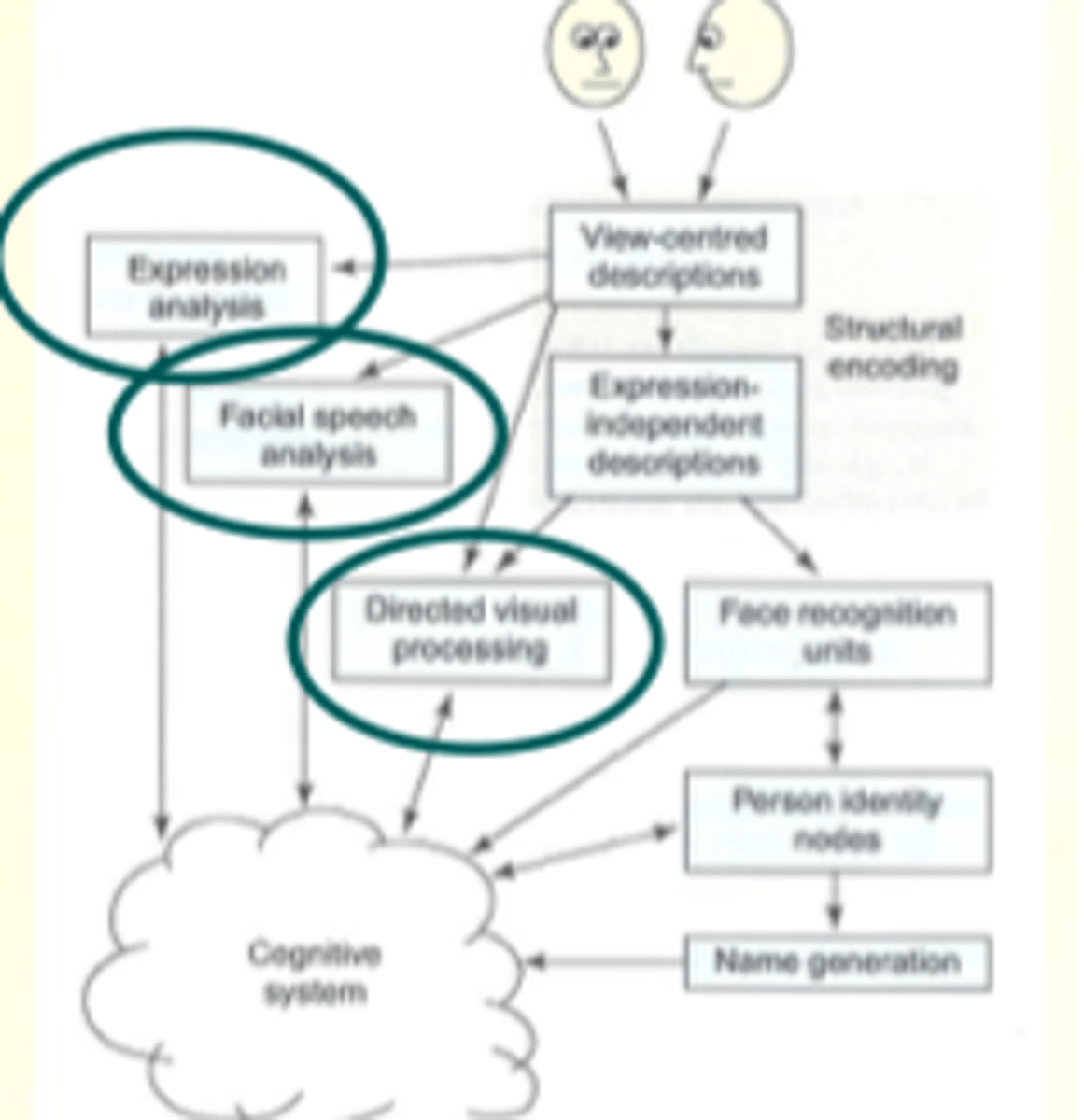
Face Recognition Units (FRU)
Bruce and Young model of face recognition
input expression indep descriptions
contains stored structural (visual) descrip of familiar faces
1 FRU per face
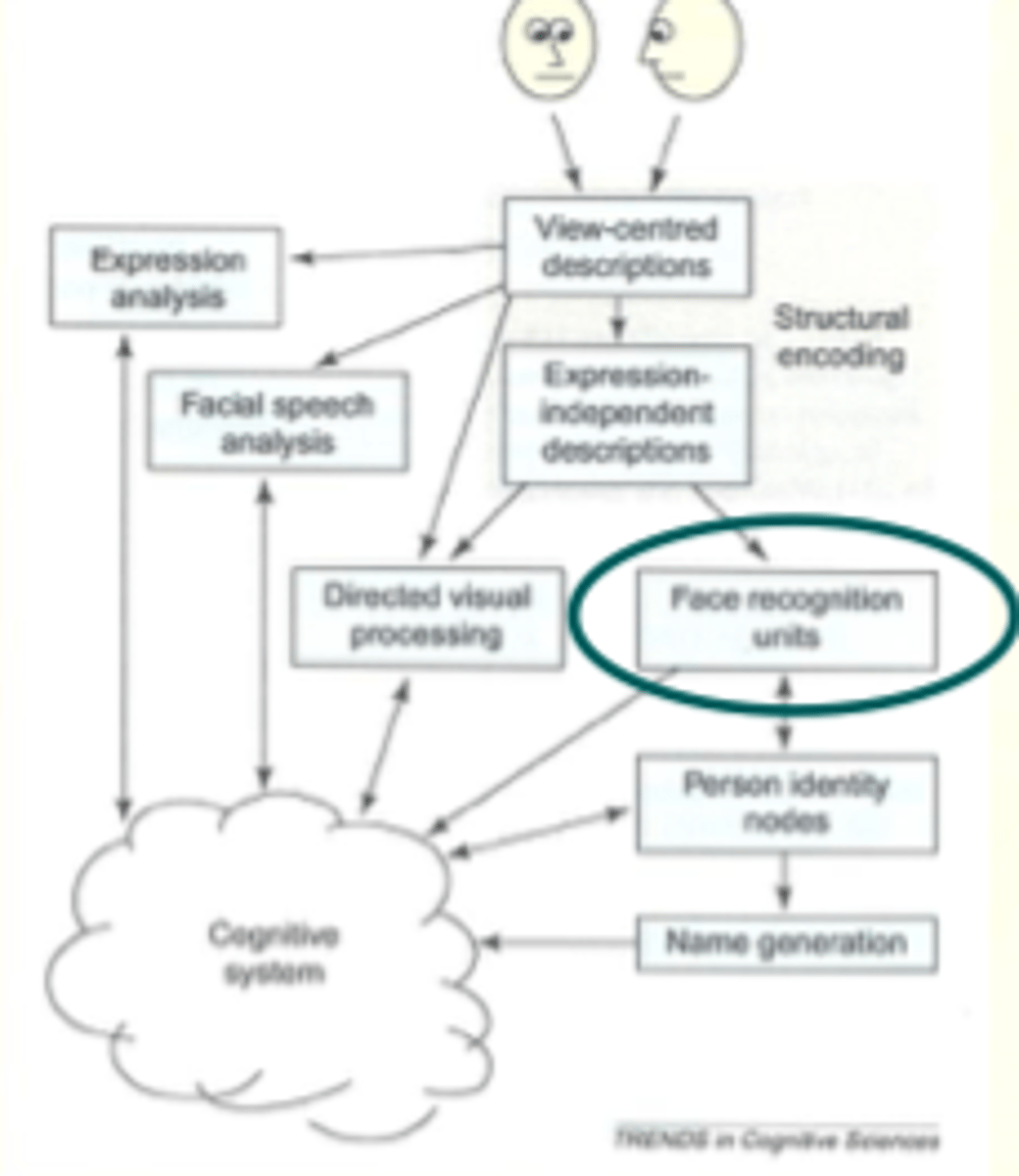
FRU activates when
when there is a strong match between the face encoded and a stored structural description
also via semantic info in person identity nodes
FRU responds to
a known face, any given angel but not to other person specific info (eg. voice)
person identity nodes (PIN)
Bruce and Young model of face recognition
post FCU activation, then semantic (bibliographic) info about person is activated (eg job, characteristics etc)
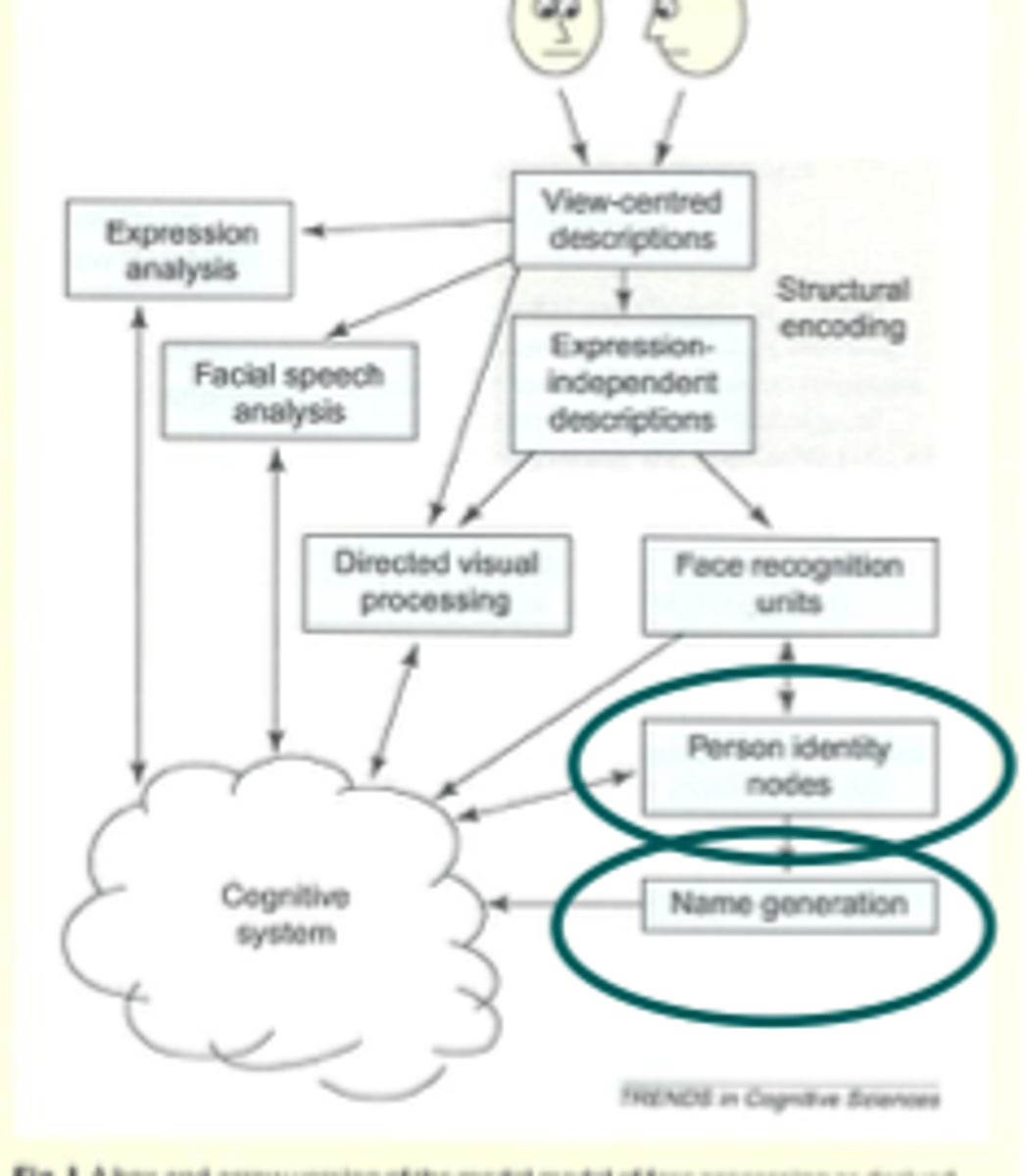
name generation stage
Bruce and Young model of face recognition
activation of the PIN and subsequently semantic info allows you to be able to name the face
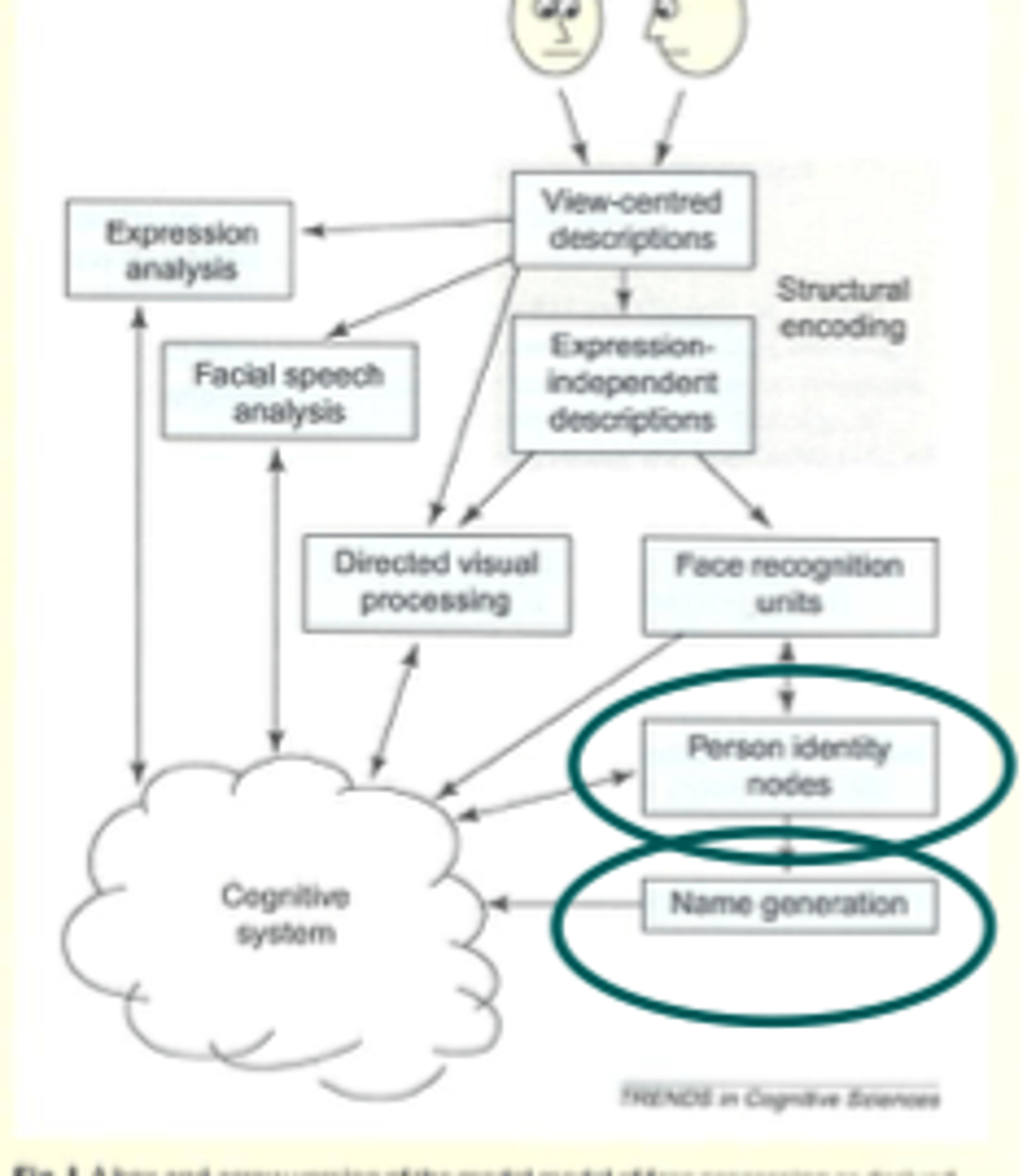
cognitive system
Bruce and Young model of face recognition
all other proc that may be involved in or relevant for face recognition
episodic memories, attention and decisional proc's
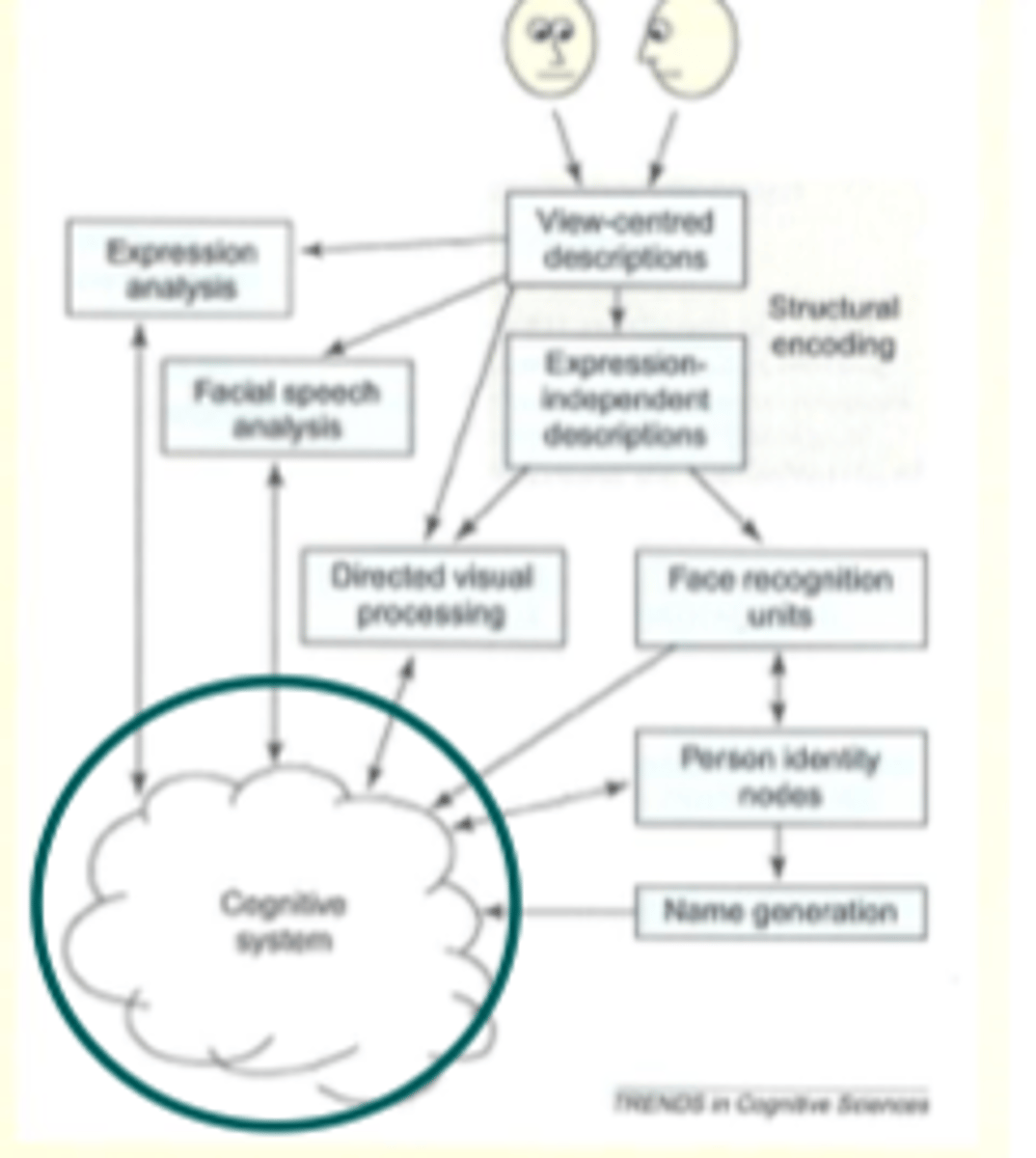
prosopagnosia types: re. Bruce and Young model of face recognition
2 distinct groups: impaired ability to perceive faces & impaired face recognition
prosopagnosia types: impaired ability to perceive faces
re. Bruce and Young model of face recognition
defect affects structural encoding- model
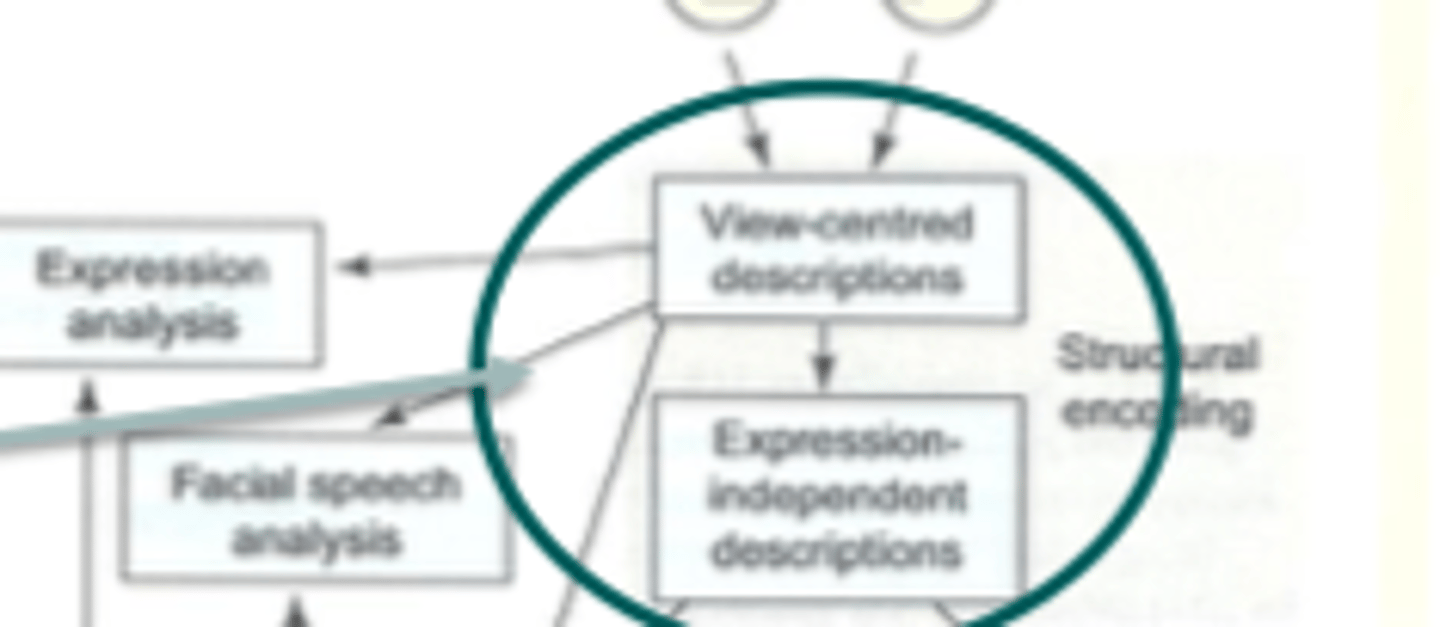
prosopagnosia types: impaired face recognition
re. Bruce and Young model of face recognition
intact perceptual abilities but cant recognise or proc faces enough. problem with FCU
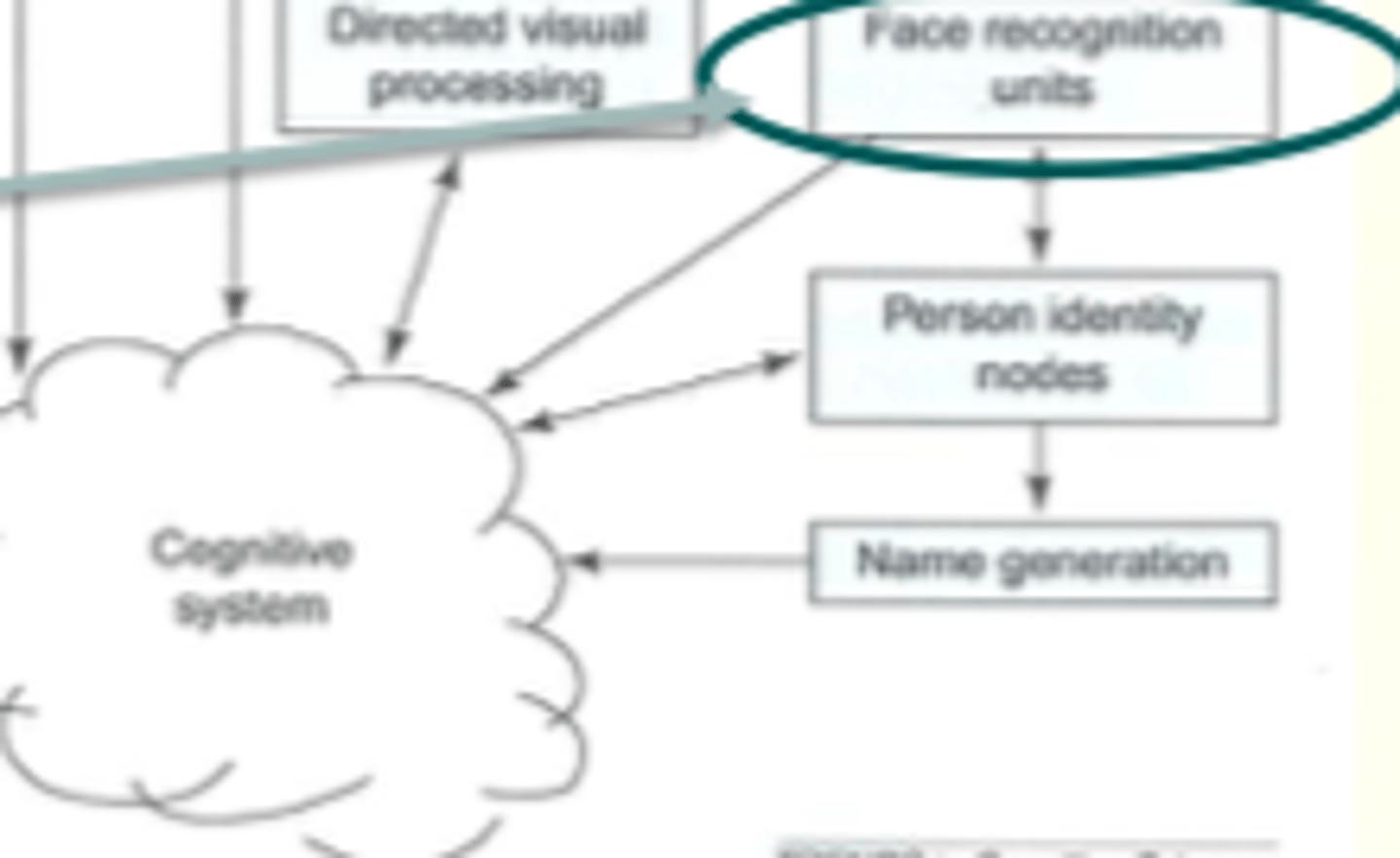
prosopagnosia: Patient PG (Young et al., 1988) (problem with perceptual proc)
re. Bruce and Young model of face recognition
damage to R side of brain. problem with perceptual proc of faces, cannot diff a face from scrambled image of face
inability to perceive faces, problem during structural encoding
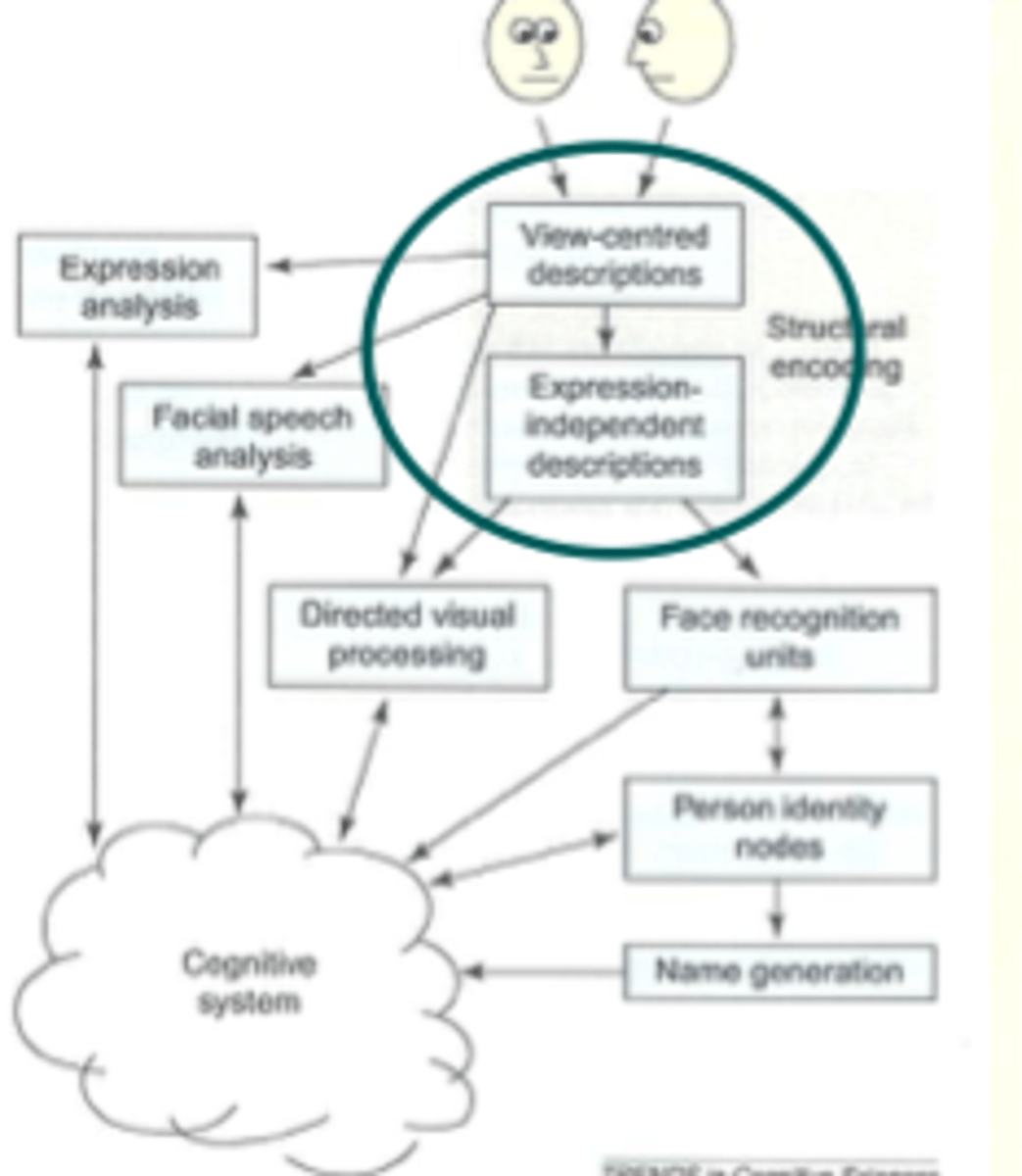
prosopagnosia: Patient PH (De Haan 1987) (problem with face recognition)
re. Bruce and Young model of face recognition
occipitotemporal lesions
could distinguish between non/faces but was at change when rating the familiarity.
count access semantic info from face
can perceive face, but not recognise
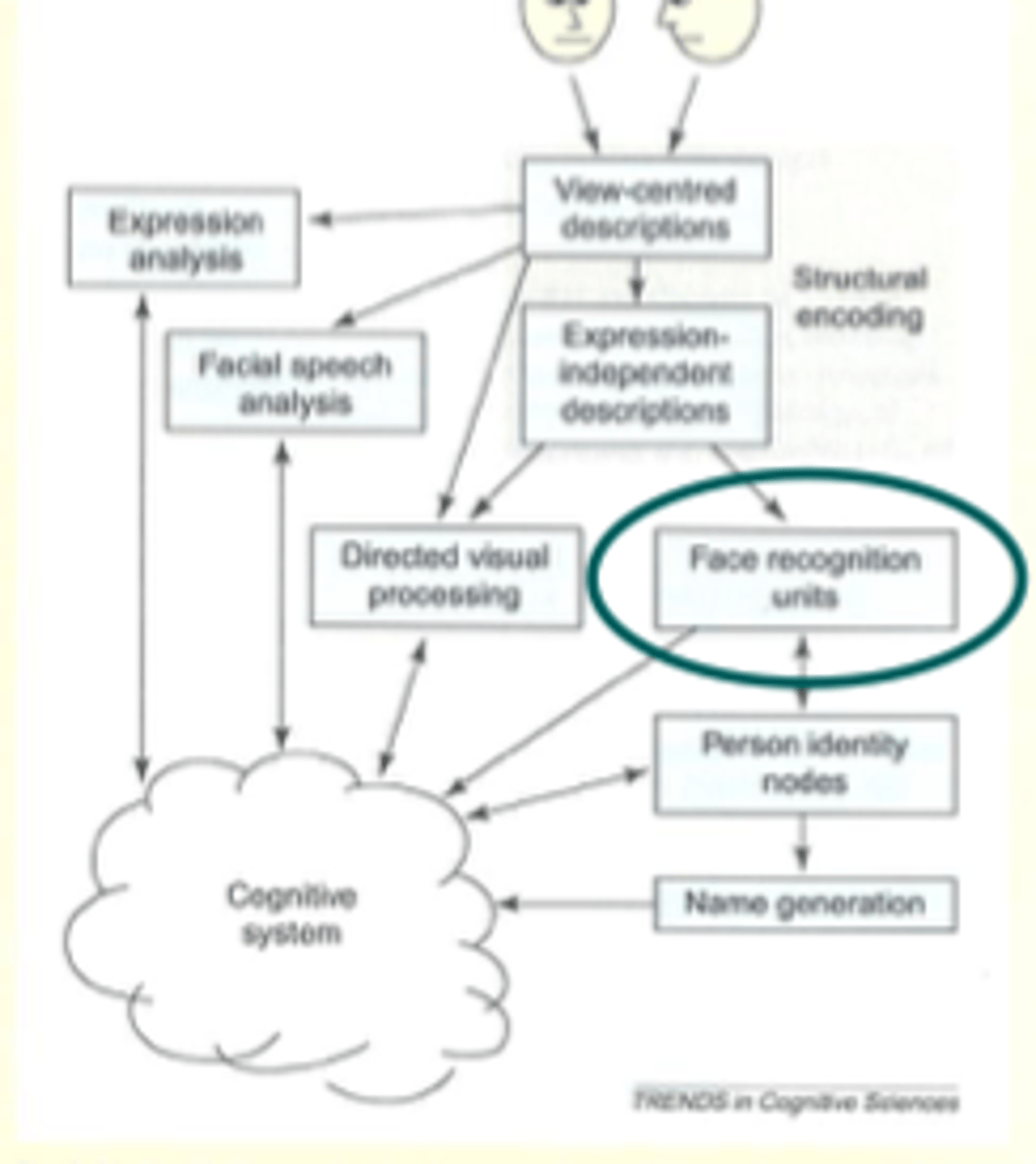
prosopagnosia: Patient ME (De Haan 1991) (problem with PIN)
re. Bruce and Young model of face recognition
could distinguish between non/faces.
could rate the familiarity of faces
could match photos from diff viewpoints
couldnt recall semantic info from face
can perceive but not recognise face
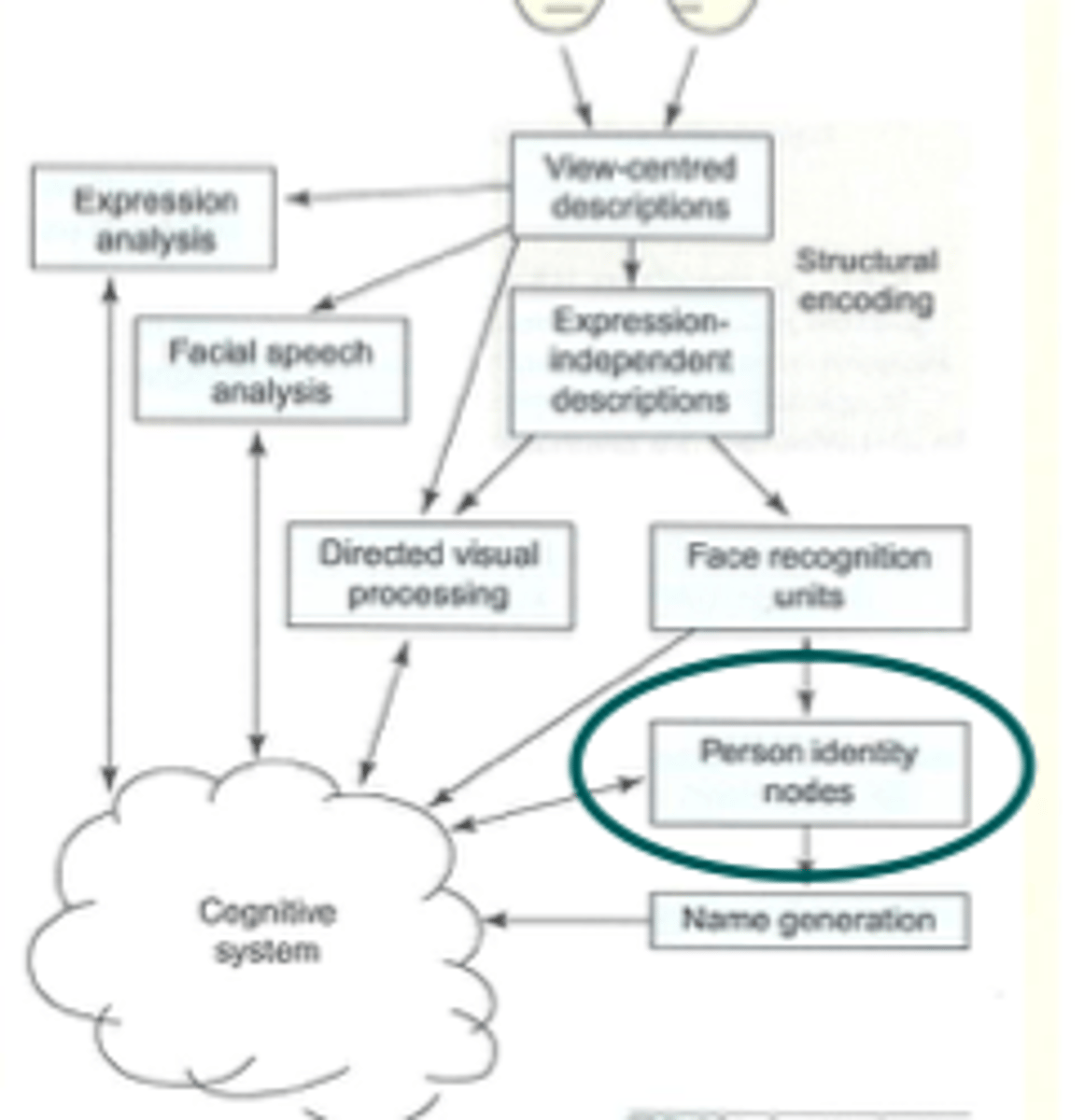
prosopagnosia: Flude et al., 1988- Problem with name generation
re. Bruce and Young model of face recognition
EST- removal of left temporal lobe
had anomia
could proc face, rate familiarity, recall semantic info
could not name the face
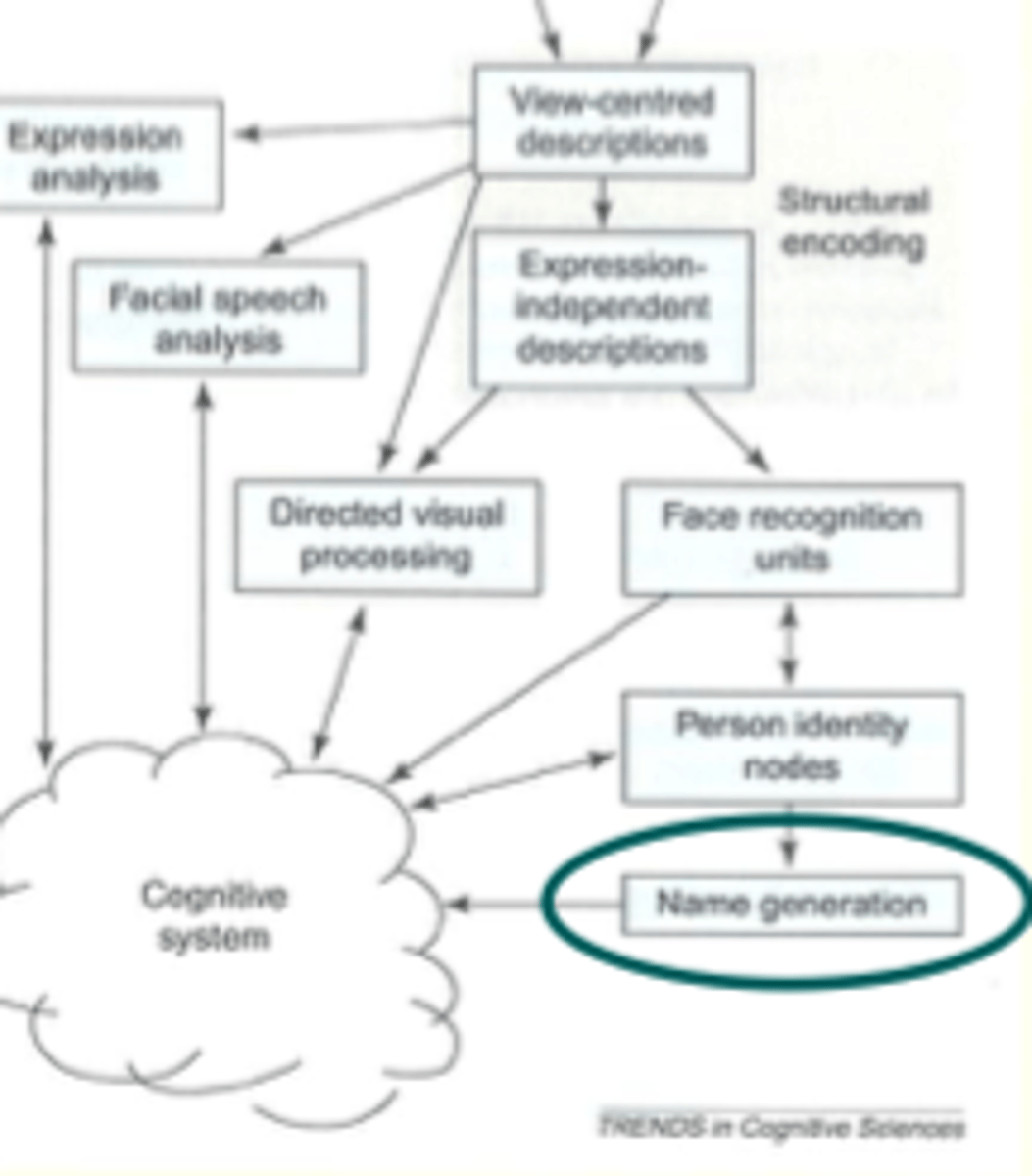
Burton, Bruce & Johnston (1990) Face Recognition Model
an interactive activation and competition network with 3 primary pools which are each connected to eachother with an inhibitory link
excitatory links connect some related units
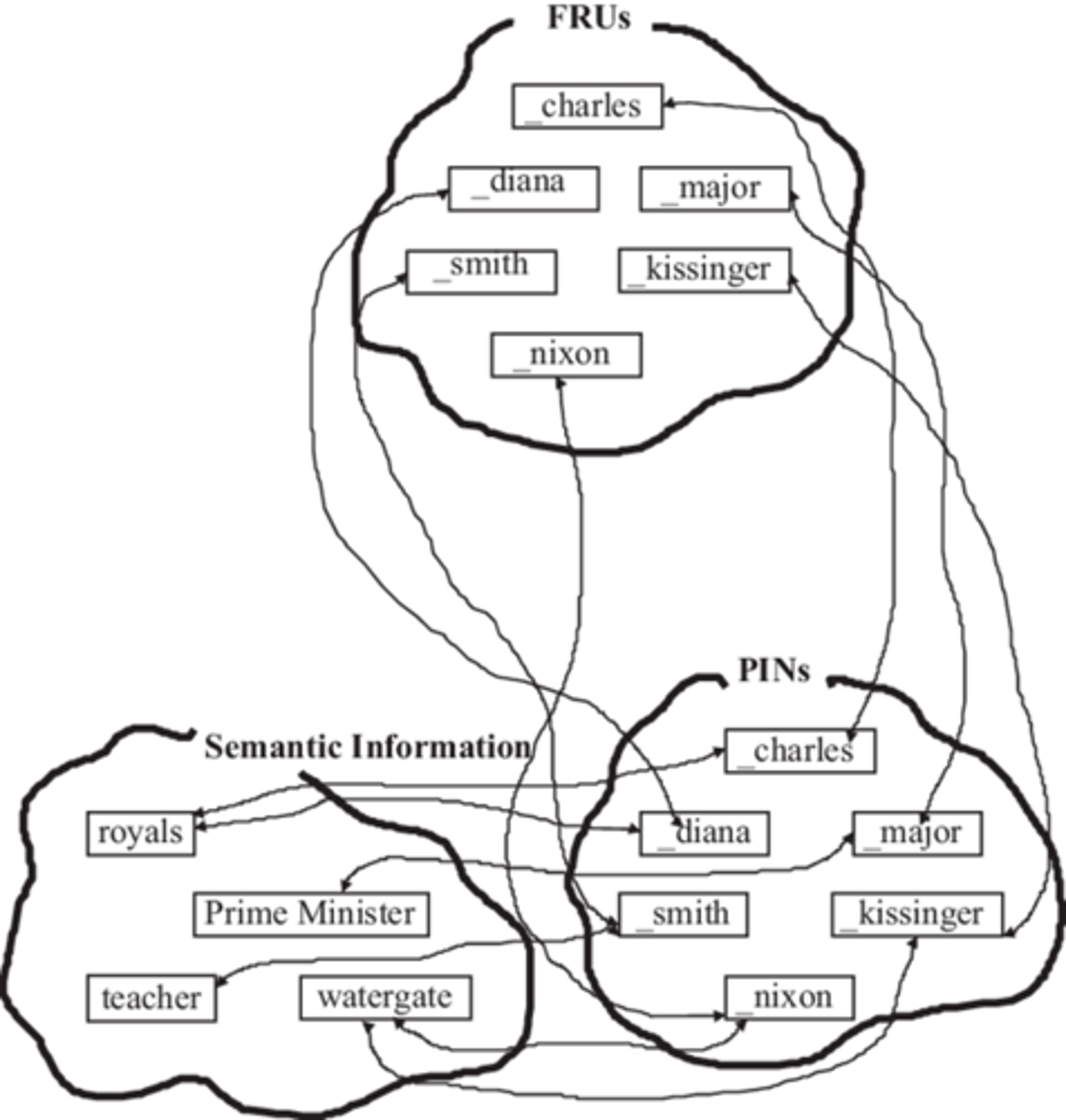
3 primary pools- what are they
Burton, Bruce & Johnston (1990) Face Recognition Model
units of face recognition units (FRUs)
person identity nodes (PINs)
semantic information units
Burton, Bruce & Johnston (1990) Face Recognition Model is an implementation of?
implementation of the Bruce and Youngs functional account of face recognition
what do FCUs represent
Burton, Bruce & Johnston (1990) Face Recognition Model
represent view-indep units that become active after presentation of any recognisable view of a familiar face
FCU activation
Burton, Bruce & Johnston (1990) Face Recognition Model
activation is passed by the appropriate excitatory link to the PIN
PIN activation is linked with?
Burton, Bruce & Johnston (1990) Face Recognition Model
linked with semantic info (associated knowledge about a person- eg. movies done by an actor)
Haxby et al., 2000 Model Face Recognition
cognitive model of face perception which overlaps the Bruce and Young- but explores core and extended neural systems
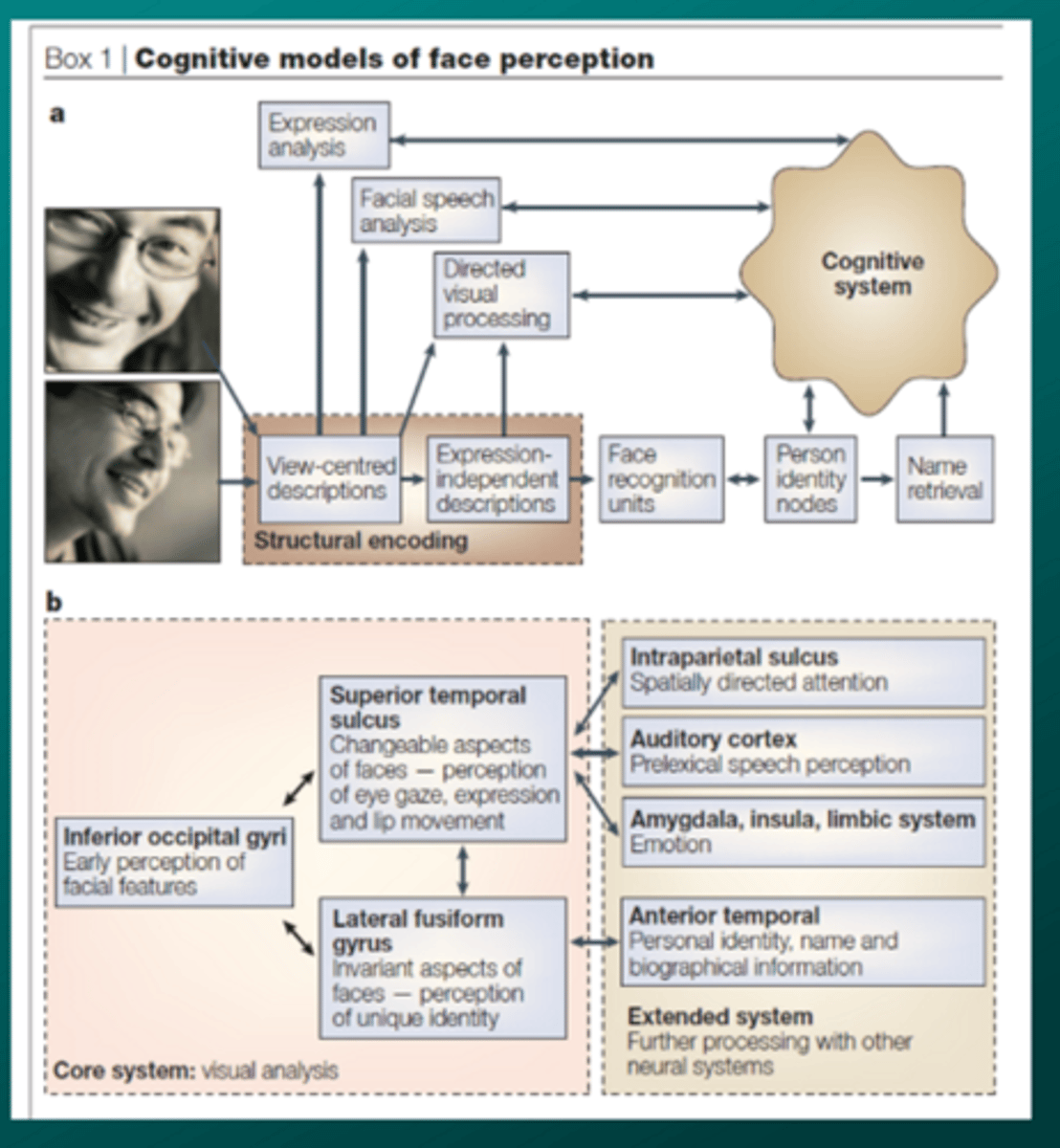
core system
Haxby et al., 2000 Model Face Recognition
VISUAL ANALYSIS
inferior occipital gyri
superior temporal sulcus
lateral fusiform gyrus
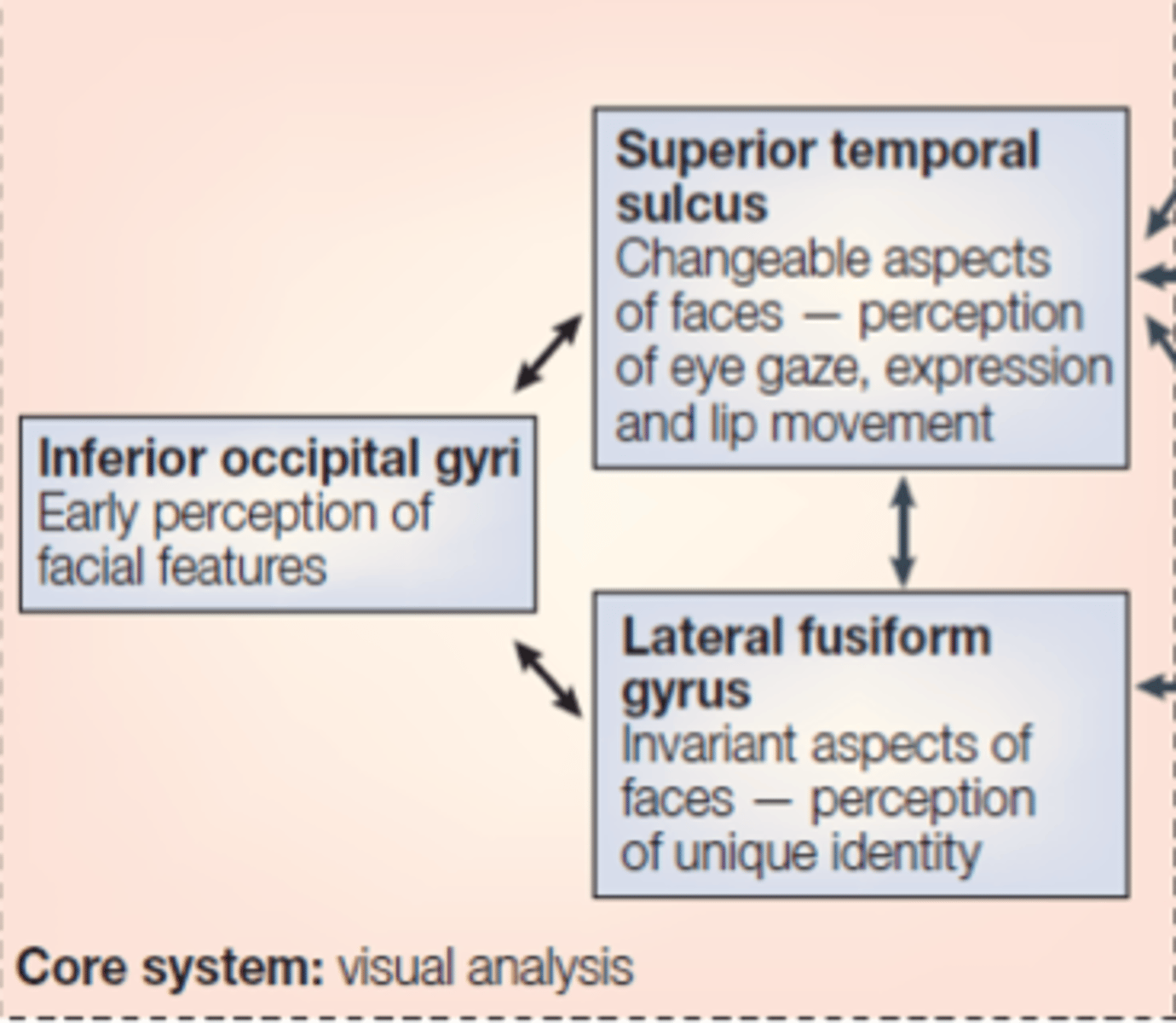
extended system
Haxby et al., 2000 Model Face Recognition
FURTHER PROC W/ OTHER NEURAL SYSTEMS
intraparietal sulcus
auditory cortex
amygdala, insula, limbic system
anterior temporal
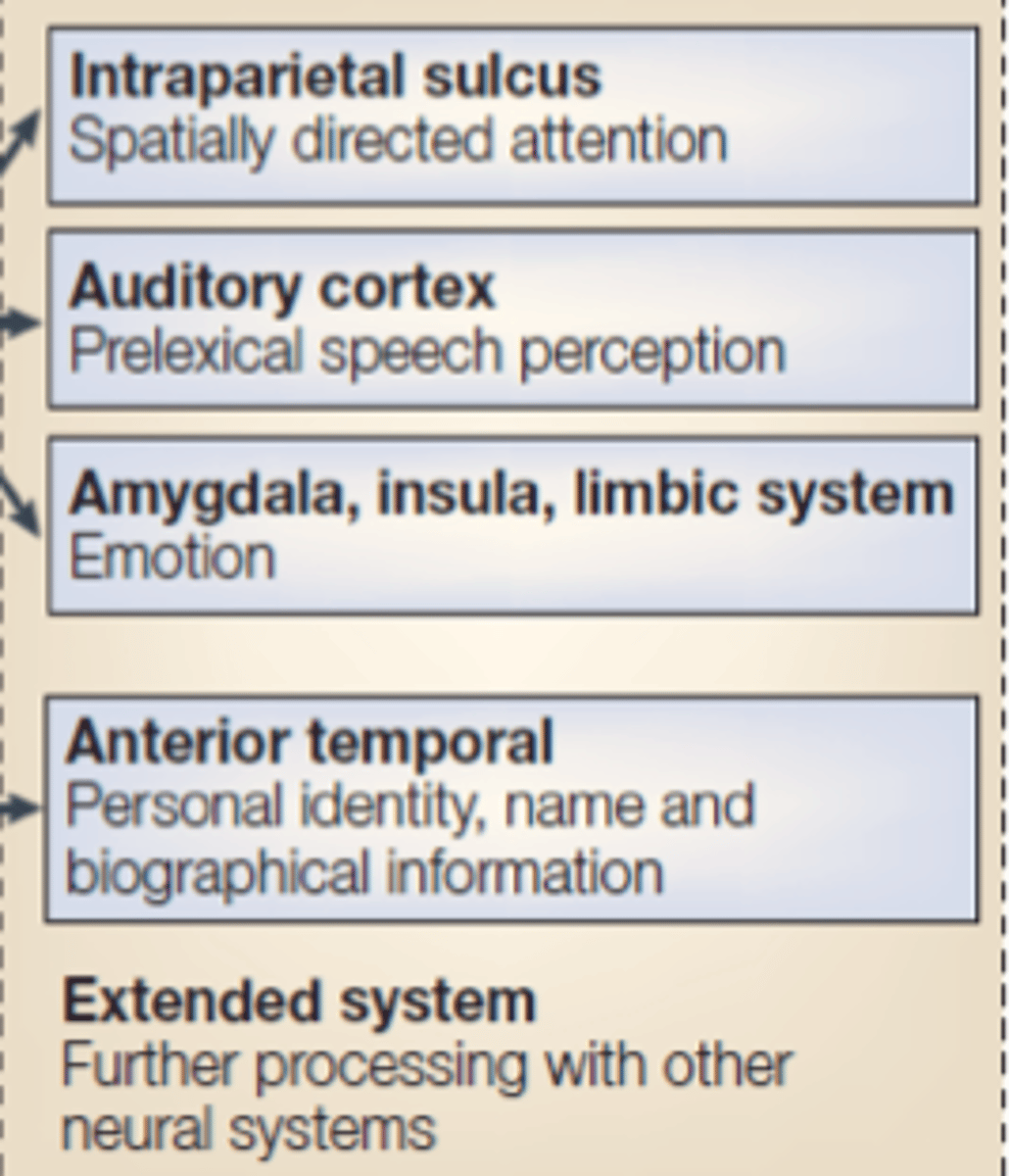
Covert face recognition physiological evidence - Patient LF (Bauer 1984)-
tas k to select the correct name from 5 alternative to match a photo of a farmiliar face
patient LF performed at chanced to identify the faces
skin conductance responses (SCRs) were greater and more frequent to the correct name compared to distractors
Covert face recognition physiological evidence- Tranel & Damasio 1985 showed pt slides of faces produced?
increased SCRs to familiar faces compared to unfamiliar faces
Covert face recognition physiological evidence- renualt et al., 1989 (ERPs, P300)
ERP P300 amp increased for familiar faces presented in an odd-ball paradigm
Covert face recognition physiological evidence- Rizzo et al., 1987 eye movement data
eye movement data of prosopagnosic similar to controls for familiar faces
Covert face recognition behavioural evidence- De Haan et al., 1987 Patient PH- evidence of covert face recognition on face match, interference paradigm, associative priming tasks
Patient PH cannot recognise familiar faces- performs at chance on forced choice test requiring to choose the familiar face of 2 items
Covert face recognition physiological evidence- De Haan et al., 1987 Patient PH- face matching tasks
showed the effect of faster match for familiar comp to unfamiliar face
Covert face recognition physiological evidence- De Haan et al., 1987 Patient PH- interference experiment/task
showed effect that took longer if name in unrelated to face
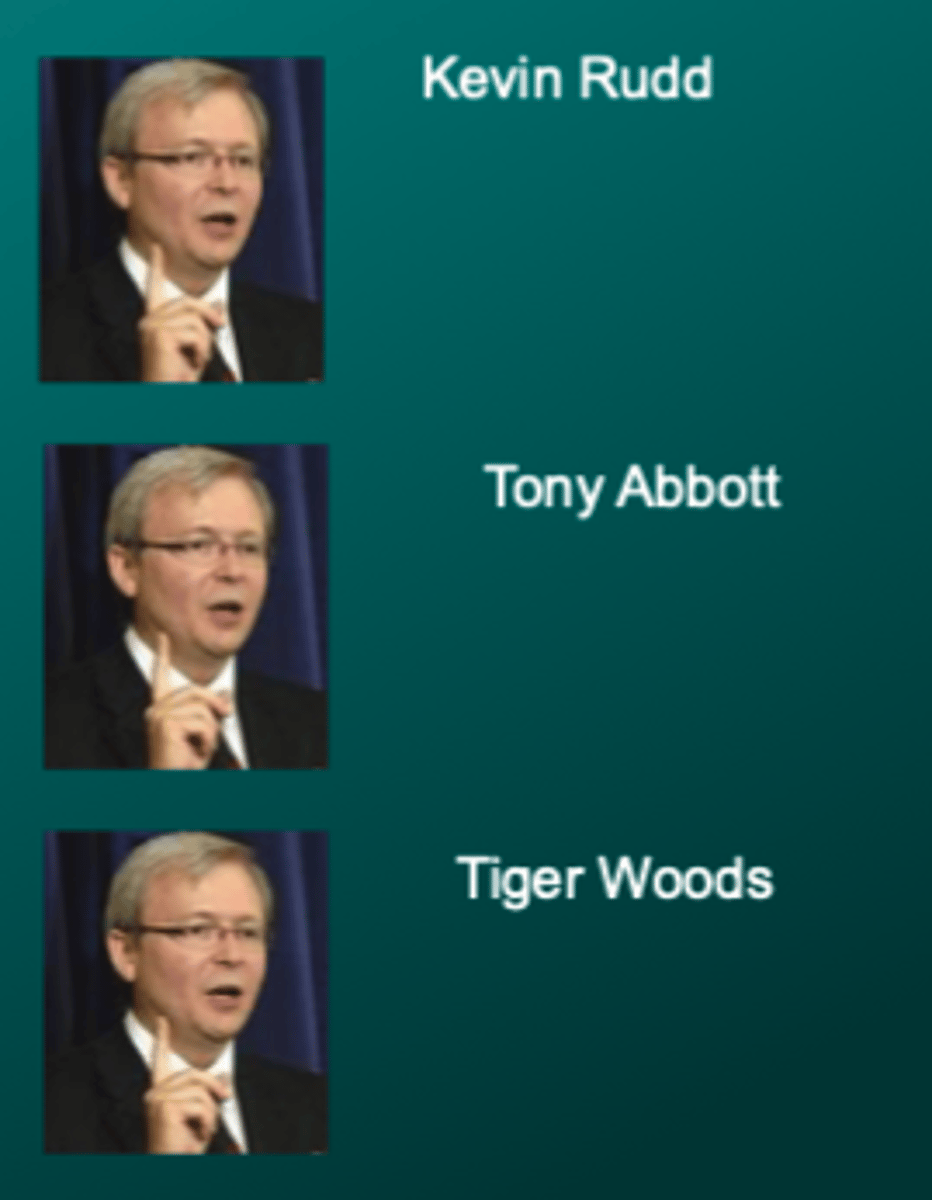
Covert face recognition physiological evidence- De Haan et al., 1987 Patient PH- associative priming exp/task
showed effect that faster response when the prime is associated with a target comp to when there is no association between prime and target or if prime is of unfamiliar person
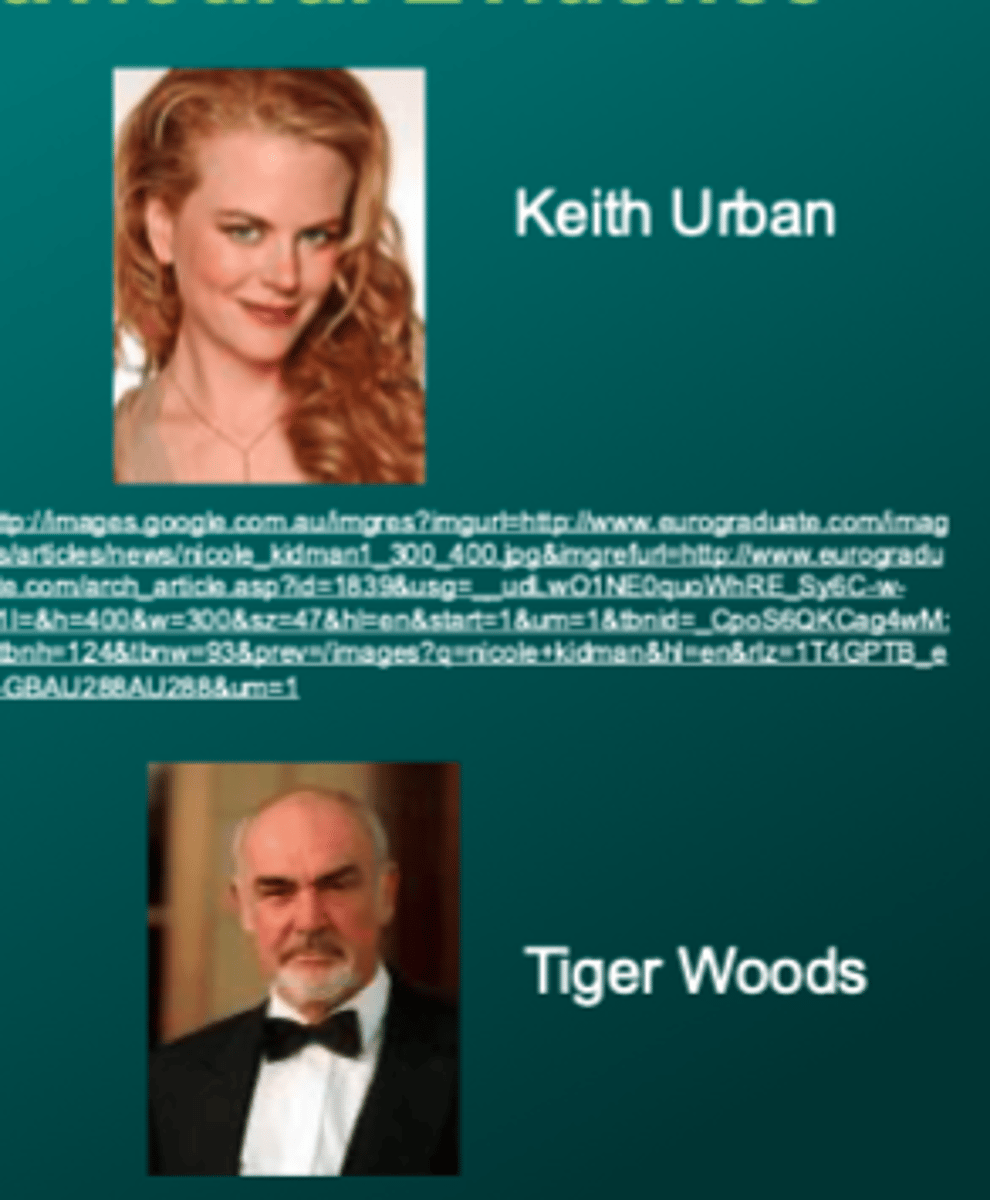
anomia- peoples names: patient GBL (McKenna & Warrington 1980)
pt anomic only for names
could only name 3/20 famous people
but could accurately say who they were 18/20
correctly could name european and english towns
face anosognosia (Young, De Haan, Newcombe 1990)- woman suffered sever R hemis stroke
poor at recognising faces, but unaware and lack acceptance of it, but she recognised her other cog impairments - maybe explained by the auto of face recog
metamorphopsia - perceptual distortion (Bodamer 1947)- 2 pts saw distorted faces
1 pt describes faces as having turned noses, uneven brows, askew mouth, hair shifted
3rd pt metamorphic but could recog faces a bit
face processing patient JS (Heutink et al., 2012)- had a stroke, reported problems in recognising family members visiting her in the hospital
Couldn't recognise daughter she sees regularly but could recognise the one she hadn't seen in years & wouldn't let grandkids sit on her lap because they looked repulsive
face processing patient JS (Heutink et al., 2012)- what did she have trouble with
had a stroke, reported problems in recognising family members visiting her in the hospital
impaired perception of facial expression, impair on benton facial recognition test
reported images of family members had distorted facial proportions but she could not tell which way
SCR arousal was higher for families

face processing patient JS (Heutink et al., 2012)- what did she have (diagnosis)
had a stroke, reported problems in recognising family members visiting her in the hospital
maybe mild metamorphopsia (prosometamorphopsia)- could be due to poor integration between identity and emotion related processing of faces
super-recognisers of faces (Russel, Duchaine & Nakayama 2009): what tests did they use
tested abilities of 4 ptps who never forget a face
before they were famous test
cambridge face memory test
cambridge face perception test
super-recognisers of faces (Russel, Duchaine & Nakayama 2009): what did this provide evidence for
tested abilities of 4 ptps who never forget a face
evidence for a continuum of face recognition skills
super-recognisers of faces (Russel, Duchaine & Nakayama 2009): how did super-recognisers perform
tested abilities of 4 ptps who never forget a face
had better face perception than control and were at the opposuite end of performance comp to prosopagnosics for upright faces
outperformed controls on before famous task